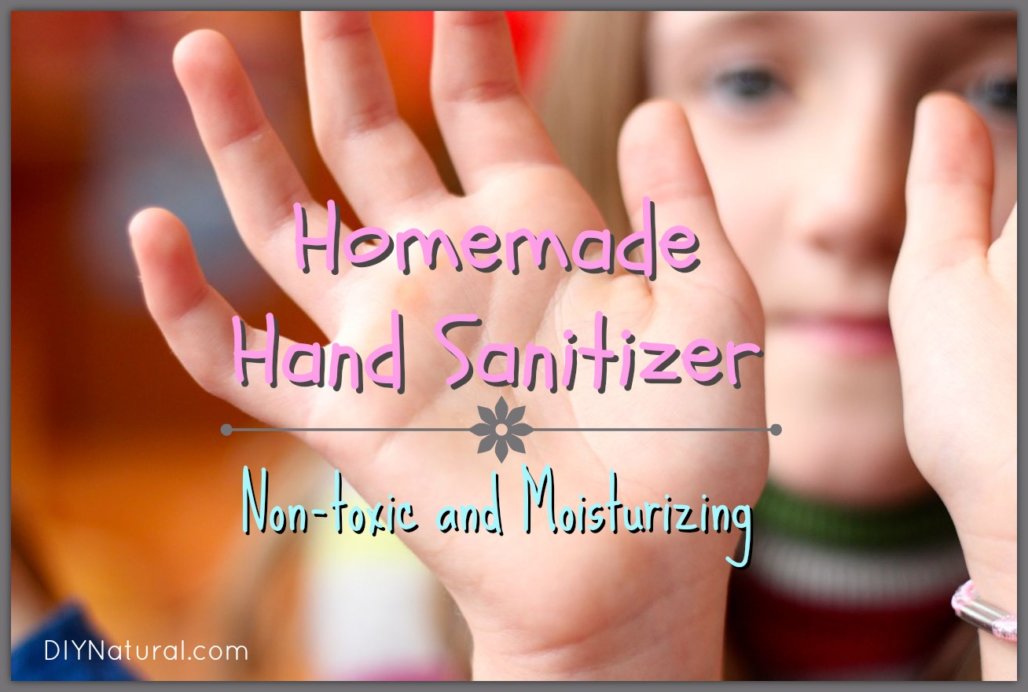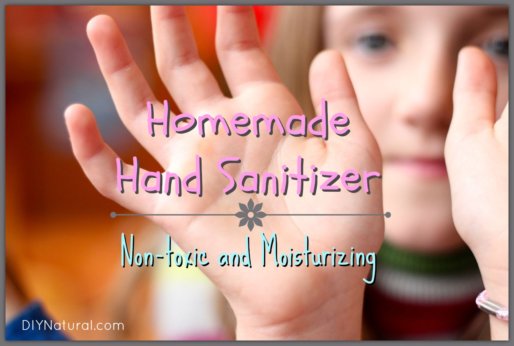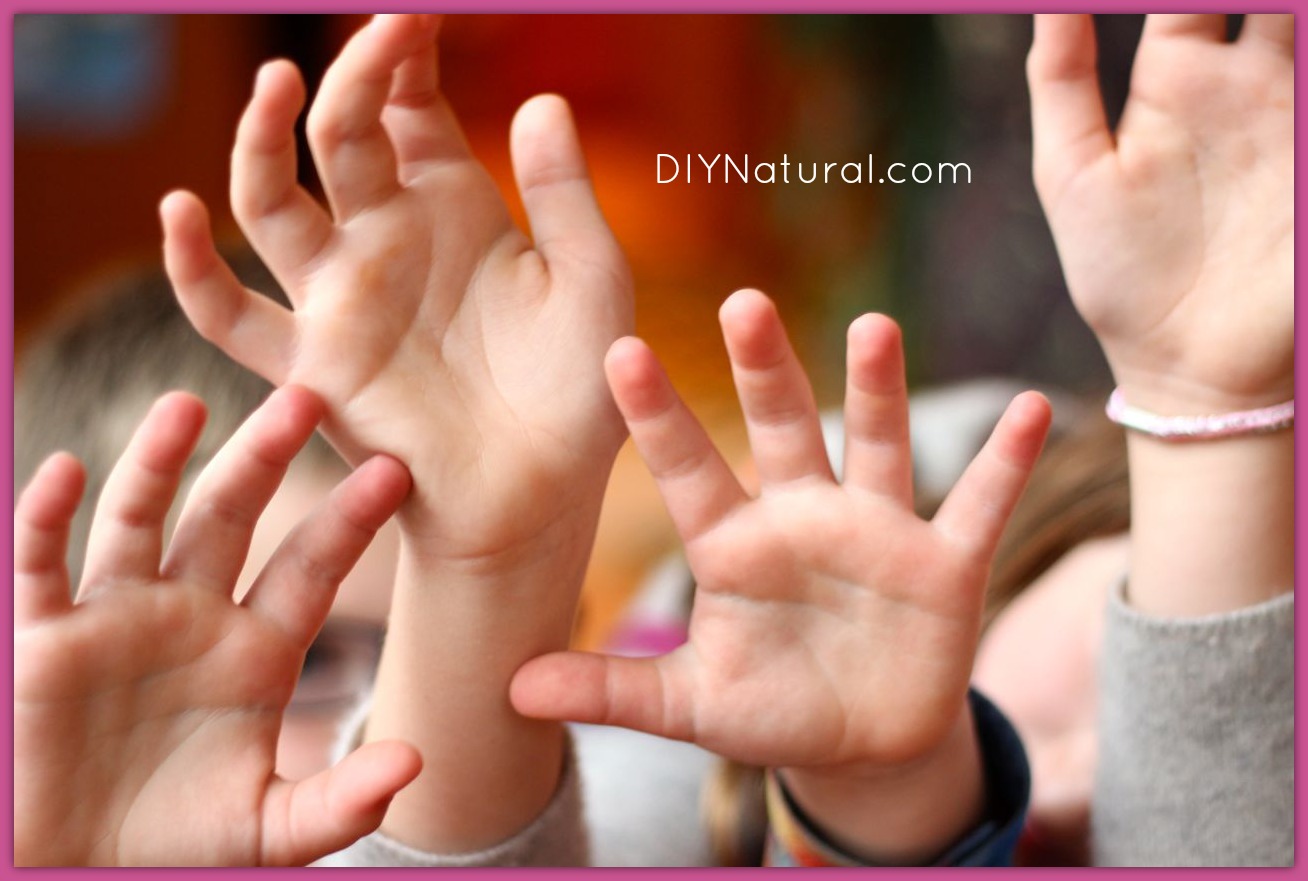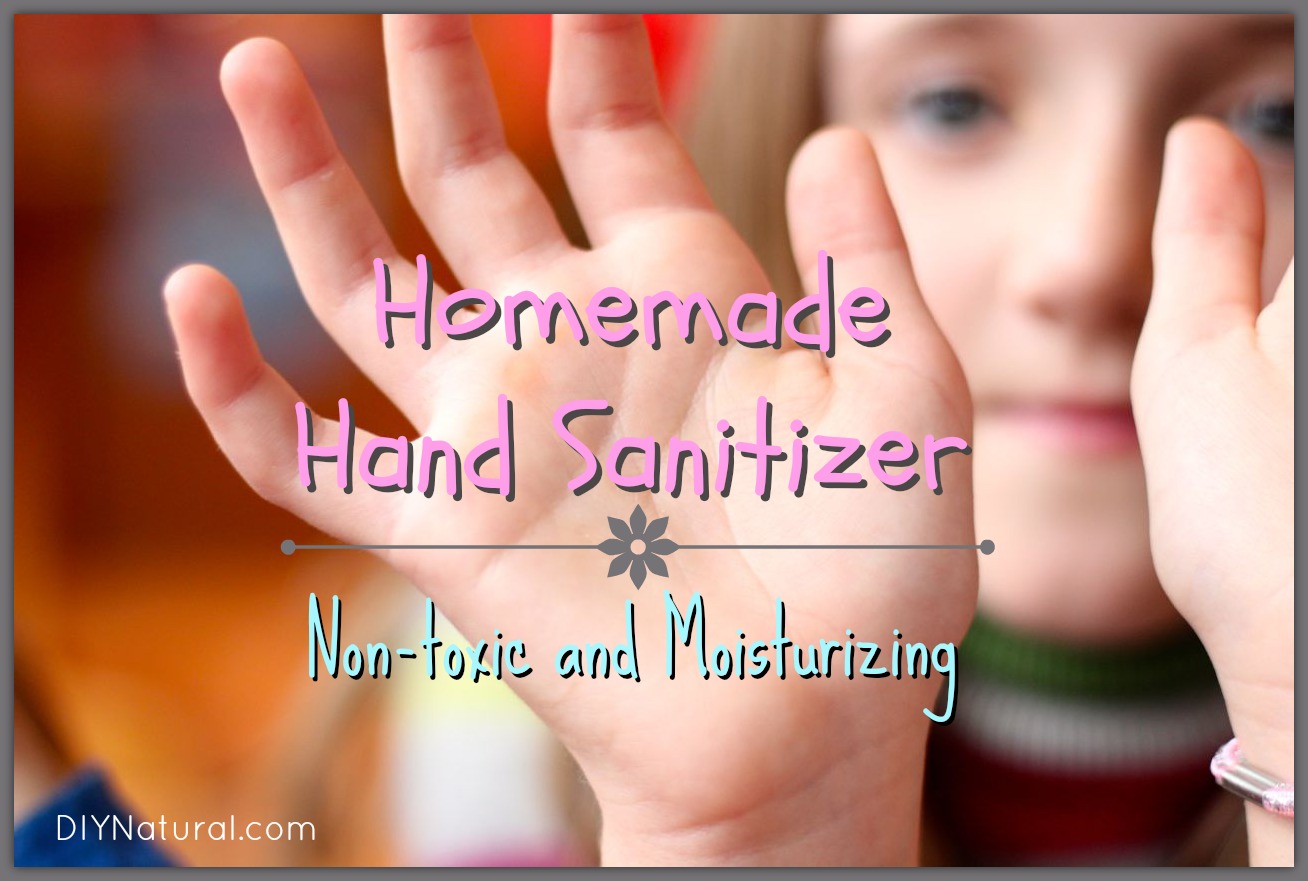
Learn how to make DIY hand sanitizer that is natural and simple. This homemade hand sanitizer works, it saves money, and fights cold and flu!
Tip: check out our homemade baby wipes too!
How to Make Hand Sanitizer
As a former public school employee, hand sanitizer was a mainstay on my desk. (And in any other strategic location that might encourage students to use it when needed.) However, I had a love-hate relationship with this germ-fighting, often offensively-scented gel.
I typically didn’t have time for the necessary 30-second hand wash while working with kids, but knew I had touched something icky, gooey, and most definitely packed with tons of bacteria. Commercial hand sanitizers smell so strongly of chemicals that I can not have them on my hands all day. More importantly, I worried about the safety of these commercial formulas for myself and the kids.
The good news? There really is no need for your nose and eyes to burn every time you apply hand sanitizer, and this DIY formula won’t dry your hands out! Learn how to make DIY hand sanitizer that is non-chemical, and naturally scented. You can make our version of hand sanitizer right at home with powerful essential oils and a few other ingredients. The essential oils I chose to use boast the following beneficial properties: antibacterial, antiviral, and anti-fungal.
* Tea tree oil has been found in clinical studies to kill most types of bacteria at a concentration of 0.5-1%.

Homemade Hand Sanitizer
Learn how to make DIY hand sanitizer that is natural and simple. This homemade hand sanitizer works, it saves money, and fights cold and flu!
- Prep Time
- 5 minutes
- Active Time
- 5 minutes
- Total Time
- 10 minutes
- Servings
- 4 ounces
- Estimated Cost
- $2
Ingredients
- 5-10 drops lavender essential oil
- 30 drops tea tree essential oil
- 3 ounces ethyl alcohol 90%+ (180+ proof) or 91%+ isopropyl (rubbing) alcohol
- 1 ounce aloe vera gel
- ¼ teaspoon Vitamin E oil helps soften hands!
Instructions
-
Add essential oils and Vitamin E oil to a small glass bowl or container and swirl to mix.
-
Add alcohol to the oils and swirl again.
-
Combine this mixture with the aloe vera gel and mix well.
-
Shake gently before each use. (Sanitizer should last several months with the addition of Vitamin E and alcohol to help preserve.)
-
Transfer hand sanitizer to small, clean squirt bottles. Also, use colored bottles like this so the essential oils in the recipe are not exposed to light. Finally, this recipe is perfect for throwing into a purse or a backpack!
Recipe Video
Notes
To make a hand sanitizer spray, simply use witch hazel instead of aloe vera gel in this recipe.
Made this recipe?
Mention @diynatural or tag it #diynatural!

Tips and warnings
The lavender is used in the recipe to round out the strong scent of the tea tree oil. If you’re not a fan of lavender, choose another antibacterial oil such as rosemary, sage, sandalwood, or peppermint. (where to buy 100% pure essential oils)
Always take care when handling essential oils. They are very concentrated, powerful plant extracts. If you are new to using essential oils you may want to test for any allergic reaction before slathering on this homemade hand sanitizer. As with any natural plant, family members could be allergic. For a simple patch test mix one drop of essential oil with about 1 tablespoon of olive oil. Rub a bit on the inside of your elbow, cover with a bandage, and wait 24 hours to see if there is any negative reaction.
Note: If you’ve been reading recent reports about how unhealthy the use of hand sanitizers can be, keep in mind that the danger exists in the chemicals used in commercial sanitizers. This homemade hand sanitizer recipe uses NONE of those harmful chemicals and relies on pure essential oils to kill germs. One of the unique qualities of essential oils is that they do not cause bacterial resistance like antibacterial chemicals, and are actually effective in killing strains of bacteria that have become resistant to our man-made medicines and chemicals. (source)
Another Sanitizer Recipe
Check out our Homemade Sanitizer Spray recipe next!
Sometimes it’s good to allow our bodies to encounter germs and strengthen our immune systems, but sometimes it’s nice to have a hand sanitizer available for emergencies. (Think dirty porta-potty or child next to you having a sneeze-fest.) In these cases, this gentle homemade hand sanitizer is one of the best alternatives to commercial brands.
*******




What’s the next best thing if we can’t find the recommended grain alcohol if we can’t find 150 or 189/190 as per comments above?
I also can’t nod rubbing alcohol anywhere…if anything it’ll be the grocery store quality stuff. I’m in MN where Everclear is illegal. I think Iowa has the 15, but 190 is illegal. I think I read that one can use gin?
Hello – I was only able to find 50% rubbing alcohol, nothing higher. Any suggestions?
Thanks – Adrienne
Thank you for the recipe! I think I have all the ingredients right now. The only question I have concerns the tea tree oil. I have read several articles that tea tree oil can be hazardous to pets. With 3 4-legged children in cheap fur coats, I am concerned about this. Any information you can pass on with be greatly appreciated.
Can I use pure glycerin in place of the aloe vera?
I made some using glycerin and alcohol with Vit E and lavender. It smells great and Purell has glycerin in it.
Locally I couldn’t find any aloe Vera gel…just the liquid you drink. Is that ok to use? Do I need to thicken it? Also is 80 proof vodka ok to use? That’s what I have on hand.
Thanks for this great recipe!
Heidi, try the area where the suntan lotions are. Also, this week Target had large pump bottles of aloe vera gel, scented and unscented, near the pharmacy.
Natural gin would seem to be another good alcohol choice with it’s juniper which is a natural disinfectant (and historical use for the same). I would probably also add a few drops of GSE
thank you for this hand sanitizer great recipe will be putting ths to use and tell others!!!Best Regards!!!
Hello,
If I use the gel from the actual plant, should I need to consider a preservative? I would love for this to last longer than a week…. perhaps a month? If I do have to use a preservative, what would you recommend I add to this sanitizer without changing its function?
FYI: vitamin E is a natural preservative.
Thank you Betsy. I’m pinning this. I would use witch hazel. But, is it OK to use rubbing alcohol if I don’t have witch hazel? Or is it best to use vodka? Thank you.
Rubbing alcohol will be fine if you’re only planning to use for a week or two but prolonged topical use is not recommended. For alcohol we use 75% (150 proof) grain alcohol like Everclear.
That’s why we use Everclear.
A solution of Everclear 150 (75% ethyl alcohol) diluted with 1 ounce of aloe vera, plus other liquids, works out to an alcohol content of less than 56%. Please consider using Everclear 189/190 instead.
For high proof vodka what percentage would you recommend?
We actually use 75% (150 proof) Everclear.
Hi. I like your recipe. I was wondering if it matters what brand of essential oil I use. I have the NOW brand, but don’t know if that is food safe, or whatever you call it. Since it will be on our hands and then we might eat something, does it matter? I also have a puppy that likes to lick! Also, can we use lavender only? (I don’t like the smell of Tea Tree)
Hi Amy,
The brand does not matter, but the purity DOES. Look for essential oils that are 100% pure, and not diluted with other carrier oils. You can use lavender only, but it will not be as effective without the tea tree. It will still kill some germs though.
Great recipe for home-made hand sanitizer. It’s good to see information getting out there about the dangers of Triclosan. Hand sanitizer based on essential oils and natural alcohols can help wipe out germs safely without putting you at risk for antibiotic resistance. Keep up the great work, Betsy!
Thanks for your kind words! It’s true — our society has been so bombarded with promises of the effectiveness of things like Triclosan, but rarely educated on the multiple dangers. And instead of trusting in the natural alternatives, many consumers think that only products made in a lab will work. We work to help consumers move away from this mindset, and are so thrilled you enjoy our work! 🙂
I’m just starting the all-natural DIY and thought this would be a good product to start with. I have a 9mo baby and am nursing though, so not sure about the tea tree oil-been researching but can’t find anything definitive one way or the other…
Also have a question about witch hazel. I bought a bottle at my local health food store called Thayers original witch hazel with aloe vera formula, got home and looked up this recipe again then realized this might not be okay to use. Should I return it and find something that specifically says that it’s witch hazel extract only?
Hi Rachel,
The witch hazel you have will work well. As far as essential oils go, I have always learned that if pregnant or nursing, products containing 1% essential oils are safe. The essential oils in this recipe only make up approximately 0.5% of the product.
Hope this helps!
I made my first batch last night and gave several of the bottles away to get feedback. I love it and most everyone I’ve “squirted” did too. The ones that didn’t, didn’t like the lavender tea tree combo. I will be trying a batch with peppermint and tea tree next.
Another good thing about this sanitizer……if you lick your fingers after putting it on it does not taste bad!!
Peppermint and tea tree would be a great combo in this sanitizer! I’m so glad everyone is liking your homemade batches. Thanks so much for returning and leaving your comments! 🙂
Perfect timing! I had been thinking about how to make my own, and once again, you beat me to it! I have an AV question though…I also use Lily of the Desert, but mine says 99% pure. It is the “Gelly” and has quite a list of ingredients such as vitamins and preservatives in addition to the aloe. Is there another type I should be looking for? I love this site and use so many of your recipes and suggestions, THANKS!
Yes, the “gelly” isn’t totally pure and natural, but it will work if that’s what you have. I typically use Lakewood Organic Pure Aloe Vera Gel. It’s usually found in the health section (as an aloe supplement that you can drink). It’s pure aloe vera gel, in a pourable consistency, that only includes a little lemon juice as a preservative. I have also used Lily of the Desert pure aloe vera gel, but they have changed the formulation recently to include a thickening agent and more preservatives. Basically, you can use whatever you’re comfortable with, but just be sure that you use an appropriate container for the consistency of your aloe gel. (For example, I would not try to use a spray bottle for your sanitizer if you’re using the thick “gelly.”) Hope that helps!
This is great! And I even have all the ingredients — awesome!
Couple of questions — is it necessary to “swirl” the ingredients? My vitamin E oil is quite thick, and would need to be stirred with something to incorporate with the essential oils. Could we stir it with something? I thought a wooden chopstick would be good, so I could throw it away if necessary, but it wouldn’t affect the ingredients (like plastic or metal might).
Also, my pure aloe vera is VERY liquidy, almost like water, so I combined them in a bottle with a spray top. If I shake it very well, do you think the important ingredients would get through the spray nozzle enough to be effective? I wish there was a way to test the efficacy of the germ-fighting!
Hi there,
You can absolutely stir the ingredients! There’s no reason in particular I said to “swirl,” other than the fact that I hate dirtying up more utensils while doing a project. 🙂 If your pure aloe vera gel is a pourable (thin) consistency, then it will work fine in a spray bottle.
Have fun making this!
I love this! I am allergic to any chemical cleaner – so, no commercial soaps and the quick cleaners leave my already damaged fingers like alligator skin. I’m thrilled to have this – no allergy to TT as I use it all the time for other things. Something I’ll be able to keep in my purse and use in public restrooms – happy day!
Betsy, what a wonderful thing to read the recipe and realize I had everything I needed to make this handy alternative. Thanks so much and I have been sending your articles to various people that needed some help. It’s really great that you two are doing this so keep up the great work!
Love and light,
Deborah
My s.son’s teacher informed me of your site and I am so thankful you have this recipe for hand sanitizer! I used to use commercial sanitizer until my s.sons teacher informed me it was toxic to kids (EEEEEK!!!!) I will be ordering the necessary ingredients and mixing up a batch to keep in my purse! Thank you 🙂
Tee tree oil is amazing but should also be used with caution until you know for sure if you are allergic. I tried it for nail fungus only to find I was allergic. I thought I would go nuts from the wicked itchy oozing bumps that lasted for over a week.
Yikes, sounds horrible! I agree everyone should perform a patch test (instructions can be found in the post under “Tips and Warnings”) if they have not used a certain essential oil before.
I made hand sanitizer using this recipe but it seems to dry out my hands. I have to use it frequently due to the nature of my work. Do you have any suggestions? I did use pure aloe vera, not the green kind. Thanks!
I would recommend adding Vitamin E oil and/or a little vegetable glycerin, which are both very moisturizing.
I wonder if coconut oil would work in some manner? “Coconut oil is very effective against a variety of infections due to its antifungal, antiviral, and antibacterial properties. According to the Coconut Research Center, coconut oil kills viruses that cause influenza, measles, hepatitis, herpes, SARS, etc. It also kills bacteria that cause ulcers, throat infections, urinary tract infections, pneumonia, and gonorrhea, etc. Coconut oil is also effective on fungi and yeast that cause candidiasis, ringworm, athlete’s foot, thrush, diaper rash, etc.” http://www.organicfacts.net/organic-oils/organic-coconut-oil/health-benefits-of-coconut-oil.html
Interesting thought! I knew it was antibacterial, antifungal, and antiviral, but hadn’t seen all of those disease-related uses for coconut oil. Thanks for the information Erin!
I bought a small aloe vera plant last so I could use the gel at home. It has multiplied into several pots now and I would like to harvest it…any special tips on it or do I just peel away the skin and blend it smooth to mix?
Check out my article on “10 Uses for Aloe Vera,” in which I link to a good tutorial on skinning your own aloe plants, and also instructions on preserving the aloe for a few months: https://www.diynatural.com/10-uses-for-aloe-vera/
Hello!
Couple of questions – for the AV does that need to be refrigerated after opening? Also do you have any recipes for an all natural foaming hand soap?
Thanks!
Check your bottle of AV to be sure about refrigeration. If it’s 100% pure aloe vera gel, it will need to be refrigerated after opening. For foaming hand soap, I put 1/3 liquid castile soap (like Dr. Bronner’s) and 2/3 water into a foaming pump. Simple! 🙂
This is a very nice recipe and I love that it’s natural too!
I am also wondering about the aloe vera gel. Is it the kind you can eat? That is what I got and it comes out kinda chunky. Mine finished product is pretty thick. I did not put it in a pump, though.
Amy, it should be pure aloe vera gel. I’m sure the consistency depends on the brand. I use Lily of the Desert Aloe Vera Gel. It’s runny enough to put in a pump bottle.
If the Aloe Gel is too thick you can put it in your blender and it will break up the lumps and make it thinner…
I used the Aloe Vera Liquid from Bulk Apothacary and put my mixture in a small bottle with a fine mist sprayer. It worked great!!
I love the idea of this. But when I made it, it was so thick I couldn’t get it into the pump bottles no matter what I did. I ended up wasting about a third of it. Did anyone else have that problem or is it just me?
I’m guessing the problem was a result of the aloe vera gel being too thick. What kind did you use? My sanitizer actually turns out pretty thin.
I would love to know about the tea tree oil as well. I am 22 weeks preggo and work in a day care, so I am constantly washing my hands. Any alternatives you would suggest for the time being?
Ps: LOVE the laundry detergent recipie!! Thanks for all you do 🙂
Carrie & Jessica,
I recommend checking with your doctor about using tea tree oil. He/she might say it’s okay to use it for topical applications, but you’ll want to ask to be sure.
From things I have read, there is not enough scientific information right now on tea tree (and a few others like rosemary & peppermint essential oil) to recommend during pregnancy/nursing. I’m also assuming that’s why all the warnings I see discourage parents from using it with infants and young children.
The following website gives more information, but you will also notice that this site says tea tree oil generally has a reputation for being safe during pregnancy…lots of contradictions out there. http://www.aromaweb.com/articles/aromatherapyduringpregnancy.asp
Read up on everything you can about these oils, consult your doctor, and make the best informed decision you possibly can! 🙂
I have had a blast on this site the last two days. The tea tree oil is in other recipes I would like to try as well. Thanks.
I am a bit concerned about this recipe. I do think that making your own sanitizer is absolutely brilliant considering the way companies probably mark-up commercial sanitizers at least 200% (and that is me being nice). However, to be effective, sanitizers must have at least 60% alcohol. This is harsh on your skin, but this is why conditioners are added to most. “A little bit” of alcohol will not do the job of killing the majority of bugs (predominantly viruses…of which there are over 200 that cause the common cold alone). I am a RN completing my Master’s and have been teaching nurses for some time 🙂 I just want you to be informed!
Thanks Stace! Keep in mind that the tea tree oil in this recipe is the germ-fighter. We believe in the therapeutic properties of essential oils. 🙂
I’m so glad I found this post. I tried making some of my own hand sanitizer. I used the knowledge of my RN friend and other research I had done. I used glycerin, alcohol, and essential oils. It was effective and helped with chapped “wintery” hands but it left a weird oily feeling to my hands. So I am super excited at trying yours!
i just wanted to point out for anyone who hasn’t tried making their own sanitizer, it will usually smell better. Some of that store bought stuff smells cheap and awful. And with the home made sanitizer, you can adjust the ingredients to your liking.
Hello!
I have used several of your other recipes to great success so I naturally had to try this one. I also researched a few other recipes and general information on the information super highway, found some interesting and hopefully useful tidbits. Armed with new data, I decided to improvise my own concoction.
12 oz aloe vera
1/3 cup rubbing alcohol
1/3 cup witch hazel
5(ish) drops of tea tree oil
25 drops of lavender oil
It has come out to be a decent consistency, smell is very lightly pleasant, no tacky feeling and few little burning in nicks and cuts. Here’s hoping it helps keep away the plague!
Thank you!
Looks like a good alternative to this non-alcohol recipe. 🙂
I can’t wait to try this! Along with doorknobs and meeting room tables, I just read that some of the germiest places are bank machines and gas pumps. I plan to keep a little bottle in my car.
Donna…although I used to keep commercial hand sanitizers in my car, I would hesitate to keep this natural hand sanitizer in the car. Keep in mind that the essential oils in the recipe will begin losing their beneficial properties if the mixture gets too hot or too cold. A bottle in your purse might be a better option. 🙂
I didn’t even realize that you could make this yourself. For some reason this made me wonder if you could make your own eye drops. Any ideas on that?
Yes, you definitely can! Matt made his own eye drops a while back, but I’m not sure what he put in them. Maybe this will have to be a future post. 🙂
Do we have to buy aloe vera gel, or can we just “milk” one of our own aloe plants? And thanks for all of your great ideas!
Great question Christine, and you’re welcome. If you have plants available for milking there’s no reason why you shouldn’t use them over buying commercially sold AV gel. Let us know how it turns out.
What a great idea!!! How long does it last before it goes bad?
Great question Aryadne! When mixed with other things, essential oils do not last indefinitely. I would make small batches that you can use up this season. Unfortunately, I can’t give a concrete expiration date like milk or bread would have, since there are so many factors that affect the shelf-life of products containing essential oils. Keep in mind that when essential oils are heated and cooled repeatedly the beneficial properties begin to deteriorate. Don’t leave in a freezing car or near a heat source in your house. 🙂